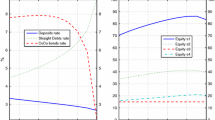Abstract
The financial crisis has emphasized the difficulties for financial companies to raise funds through conventional liabilities. In this environment, hybrid securities are becoming popular. In this paper we study the optimal capital structure of a company issuing a particular type of hybrid security: perpetual contingent capital, i.e., debt that converts into equity under some conditions. A two-period model with endogenous bankruptcy for a company with equity, straight debt and contingent capital is analyzed. We investigate the instrument under different conversion rules: automatic or optimally chosen by equity holders. We show that contingent capital reduces the coupon of straight debt and expected bankruptcy costs but can require a high spread. A trigger imposed by the regulatory authority in terms of par value of debt may induce a little use of contingent capital with an increase of bankruptcy costs.
Similar content being viewed by others
References
Acharya, V., Gujral, I., Shin, H.S.: Dividends and bank capital in the financial crisis of 2007–2009. NBER Working Paper No. 16896 (2009)
Admati, A., Pfleiderer, P.: Increased-liability equity: a proposal to improve capital regulation of large financial institutions. Stanford GSB Research Paper No. 2043 and Rock Center for Corporate Governance Working Paper No. 68 (2009)
Albul, B., Jaffee, M.D., Tchistyi, A.: Contingent convertible bonds and capital structure decisions. University of Berkeley Coleman Fung Risk Management Research Center Working Paper No. 2010–01 (2010)
Basel Committee on Banking Supervision: Strengthening the resilience of the banking sector, Consultative document (2009)
Basel Committee on Banking Supervision: Proposal to ensure the loss absorbency of regulatory capital at the point of non-viability, Consultative document (2010)
Benston, G., Irvine, P., Rosenfeld, J., Sinkey, J. Jr.: Bank capital structure, regulatory capital, and securities innovations. Federal Reserve bank of Atlanta Working Paper No. 2000–18 (2000)
Bernanke, B.: Financial regulation and supervision after the crisis: the role of the Federal Reserve. Remarks Given at the Federal Reserve Bank of Boston 54th Economic Conference (2009)
Bielecki T.R., Rutkowski M.: Credit Risk: Modelling, Valuation and Hedging. Springer, Berlin (2001)
Chemmanur, T., Nandy, D., Yan, A.: Why issue mandatory convertibles? Theory and empirical evidence. No 456, Econometric Society 2004 North American Winter Meetings (2004)
Das S., Sundaram R.: An integrated model for hybrid securities. Manag Sci 53, 1439–1451 (2007)
Décamps J.P., Djembissi B.: Switching to a poor business activity: optimal capital structure, agency costs and covenant rules. Ann Finance 3, 389–409 (2007)
Dixit K.A., Pindyck R.S.: Investment Under Uncertainty. Princeton University Press, Princeton (1994)
Duffie, D.: Contractual methods for out of court restructuring of systematically important financial institutions. Submission Requested by the US Treasury Working Group on Bank Capital, Stanford University, Stanford (2009)
EU Commission: Public consultation regarding further possible changes to the Capital Requirement Directive (“CRD”) (2010)
Evanoff, D., Wall, L.: Subordinated debt and bank capital reform. Federal Reserve Bank of Atlanta Working Paper No. 2000–24 (2000)
Flannery, M.: No pain, No gain? effecting market discipline via “reversed convertible debentures”. Working Paper, University of Florida, Gainesville (2002)
Flannery, M.: Stabilizing large financial institutions with contingent capital certificates. Working Paper, University of Florida, Gainesville (2009)
Glasserman, P. Wang, Z.: Valuing the treasury’s capital assistance program. Federal Reserve Bank of New York, Staff Report No. 413 (2009)
Goldstein R., Ju N., Leland H.: An EBIT-based model of dynamic capital structure. J Bus 74, 483–512 (2001)
Hart, O., Zingales, L.: A new capital regulation for large financial institutions. The CEPR/ESI 13th Annual Conference on Financial Supervision in an Uncertain World (2009)
Jensen M., Meckling W.: Theory of the firm: managerial behavior, agency costs and ownership structure. J Finance Econ 3, 305–360 (1976)
Kashyap, A., Raja, R., Stein, J.: Rethinking capital regulation. Federal Reserve Bank of Kansas City Symposium on Maintaining Stability in a Changing Financial System, Jackson Hole, Wyoming, 21–23 August (2008)
Leland H.: Corporate debt value, bond covenant and optimal capital structure. J Finance 49, 1213–1252 (1994)
Leland H.: Agency costs, risk management, and capital structure. J Finance 53, 1213–1243 (1998)
McDonald R.: Contingent capital With a dual price trigger Working Paper. Northwestern University, Evanston (2010)
Pennacchi, G.: A structural model of contingent bank capital. Federal Reserve Bank of Cleveland Working Paper No. 2010-04 (2010)
Squam Lake Working Group: An expedited resolution mechanism for distressed financial firms: regulatory hybrid securities. Working Paper (2009)
Yu, P., Van Luu, B., Werner, N.: Lessons from the collapse in hybrid bank capital securities. Working Paper, University of East London (2009)
Author information
Authors and Affiliations
Corresponding author
Rights and permissions
About this article
Cite this article
Barucci, E., Del Viva, L. Dynamic capital structure and the contingent capital option. Ann Finance 9, 337–364 (2013). https://doi.org/10.1007/s10436-012-0188-z
Received:
Accepted:
Published:
Issue Date:
DOI: https://doi.org/10.1007/s10436-012-0188-z
Keywords
- Callable contingent capital
- Convertible contingent capital
- Bankruptcy costs
- Dynamic capital structure
- Leverage




